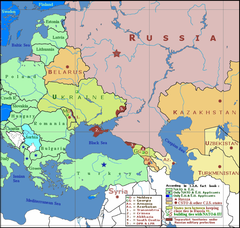
| Part of a series on |
| War (outline) |
|---|
 |
In international relations, a frozen conflict is a situation in which active armed conflict has been brought to an end, but no peace treaty or other political framework resolves the conflict to the satisfaction of the combatants. Therefore, legally the conflict can start again at any moment, creating an environment of insecurity and instability.
The term has been commonly used for post-Soviet conflicts, but it has also often been applied to other extended and unresolved territorial disputes.[1][2][3] The de facto situation that emerges may or may not match the official position asserted by either party to the conflict. For example, in the Division of Korea, both North Korea and South Korea officially assert claims to the entire peninsula; however, there exists a well-defined border between the two countries' areas of control.
Frozen conflicts sometimes result in partially recognized states. For example, the Republic of South Ossetia, a product of the frozen Georgian–Ossetian conflict, is recognized by eight other states, including five UN member states; the other three of these entities are partially-recognized states themselves.
Since aggressors are not defeated, frozen conflicts can be seen as appeasement and rewarding aggression.[4]
| Part of a series on |
| History of the Cold War |
|---|
 |
- ^ Simon Tisdall (2010-09-22). "This dangerous new world of self-interested nations". The Guardian. Retrieved 2014-03-22.
- ^ "North and South Korea: A Frozen Conflict on the Verge of Unfreezing?". Isn.ethz.ch. Retrieved 2014-03-22.
- ^ "Europe: Frozen conflicts". The Economist. 2008-11-19. Retrieved 2014-03-22.
- ^ Jung, Karsten (2023). "A New Concert for Europe: Security and Order After the War". The Washington Quarterly. 46: 25–43. doi:10.1080/0163660X.2023.2192137.